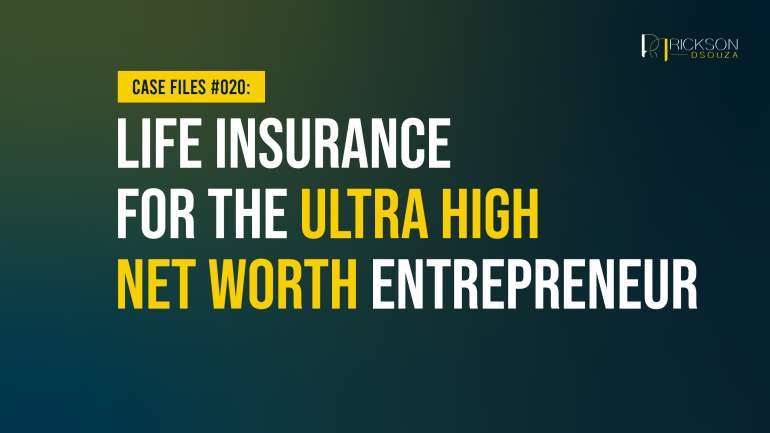Over the last few weeks, I’m finding myself in an increasing number of conversations with ultra-high-net-worth entrepreneurs and their families.
These businesspeople and their families often have one recurring question: ‘When we’ve got so much of everything, why do we need even more?’
They’ve got abundant cash reserves, hefty investment portfolios (enough for them to lead very, very comfortable lives simply off the returns), profitable businesses and what seems like a bottomless pot of gold.
Why does a family like that need Life Insurance? To add another 25 million to the pot? Not really.
Let me tell you about Ehsan, a client who had exactly that question and is now in the process of purchasing a total of US$ 125 million of life cover split amongst two generations of his family.
Background
Ehsan, aged 43, is the second generation of a family empire. His family values hard work and humility – they built their empire brick by brick. Ehsan’s father, aged 75, and the patriarch of the family moved to Dubai over four decades ago and set up a business.
Ehsan didn’t grow up with much. He didn’t go to the best schools or get driven around in nice cars. Even today, when the family is worth upwards of US$650 million collectively, they live a modest existence by those standards.
Ehsan first bought a Life Insurance policy from me back in 2020. The Life Insurance company cleared him for US$ 60 million of life cover back then. He chose, however, to buy only US$ 6 million. His reasons? He already had US$ 25 million of life cover in place, and he didn’t see the need to leave his children behind with more. ‘US$ 25 million, in addition to their slice of a $650 million family empire is plenty.’
It is. So then why are we talking about more Life Insurance?
This isn’t a case study with a challenge for us to overcome. It’s the other favorite kind for us entrepreneurial folk: It’s an opportunity.

The Opportunity
Today, Ehsan and I are discussing $125 million of Universal Life Insurance cover collectively for two generations of the family. We’re discussing US$ 100 million of life cover for Ehsan himself, and an additional US$25 million worth of life cover for his father.
The opportunity on the table is this: A (down-sizable) US$ 125 million of life cover, ringfenced and protected, added to the family pot in return for a US$ 33 million investment.
Purchasing this life cover in the form of a Universal Life Insurance policy means that the family can withdraw from the premiums paid into the policy.
This sum of money becomes an additional cash lifeline in the event of Ehsan’s or his father’s death. It would also be completely ring fenced and protected from the courts, debt collectors or any other authorities, putting Ehsan and his loved ones in full control of the premium amount paid into the policies and the payout from the policies upon the death of the insured persons.
But the policies get more expensive for Ehsan and his dad with every passing day. They also might not be an option on the table at all at some point in the future.
Like with most opportunities, timing is critical with this one.
Why Today, Why Now
Here are the reasons Ehsan is engaging in this conversation today, despite his initial questions about his need for Life Insurance.
1. Age and health affect the price It’s interesting for us to see what the Life Insurance companies offer Ehsan and his dad. Ehsan’s dad, in essence, would be paying US$ 16 million for US$ 25 million of life cover, whereas Ehsan has been offered a US$ 100 million policy for US$ 17 million.
Once again, that is:
$16 million for $25 million of life cover, at age 75 (for Ehsan’s dad)
And
$17 million for $100 million of life cover, at age 43 (for Ehsan).
Age and health affect the price of a Life Insurance policy significantly. If he is going to buy the policy, then waiting could mean a significant jump in price for the exact same product. That could hurt a bit.
2. Age and health affect eligibility: I’ve seen this over and over again. Entrepreneurs put off buying Life Insurance, and then a heart attack or some other unforeseen health condition renders them uninsurable.
This could result in the price of the policy going up astronomically, but finally, it could make them completely uninsurable.
3. A ringfenced pot of liquidity: No matter how abundant your resources are, or how sound your business model is, the future is unknown.
Should any unfortunate circumstances hit the family and their finances tomorrow, the premiums paid into a Universal Life Insurance plan as well as the payout from the policy remain a ringfenced, protected and impenetrable pot of money. The buyer of the policy has full control over who is allowed access to the funds.
This one factor alone could have reversed the fate of so many family empires that have crumbled because of one fatal blow.
4. $100 million for $17 million: A $100 million dollar life insurance policy for Ehsan, aged 43, and at the peak of his health costs US$ 17 million.
That’s approximately a 5.8x return on the capital, in the event that Ehsan dies. For families like Ehsan’s, the first and second-generation wealth-builders are often concerned about building eternal wealth – legacies that last long after they are gone.
Putting $17 million into the pot to create a US$ 100 million return is one way to put a little into the pot to get a lot more out of it. Sitting in the bank, that US$ 17 million would remain just that, with perhaps an incremental interest amount tacked on to it.
A Policy That You Can Pass Down: Intergenerational Transfer of Insurance

In addition to these benefits, the product that Ehsan and his father are considering has a new feature within a Universal Life Insurance policy: Inter-generational Transfer of Insurance.
And I don’t mean in the form of a payout to a next-generation beneficiary – that’s commonplace with Life Insurance, of course.
This particular feature allows you to change the insured person on the contract. This means that in the future, say, 12 years from now when Ehsan is 55, if he wanted to transfer his policy to his son’s name, it would be his son that becomes the insured party.
How does this make a difference? I’ll dive into the workings of Inter-generational Transfer of Insurance in another article, but here’s the essence:
Ehsan’s son, Ahaan, can replace his dad as the insured person on the policy in the future.
In essence, Ehsan starts the policy with a life cover of US$100 million at age 43, with the cost of the policy at US$ 17 Million. By the time Ehsan turns 55, the policy value would have potentially grown to an estimated US$21 million.
At this point, Ehsan can choose to carry out a “Change of Life Insured” on his policy and transfer it to his son. However, since the premiums for a cover of $100 Million for his son, at age 25, would only by $9.2 Million, the balance amount of (US$ 21 million – 9.2 million) $11.8 Million dollars can be withdrawn from the policy.
In Conclusion
I know what you’re thinking. This sounds too good to be true, right? But this really is it.
Life Insurance is a sceptically-viewed wrap for one of the most lucrative investment plans you will ever come across.
The simple construct of it is: Ehsan and his family can add an additional US$ 125 million to the family estate for US$ 33 million. The opportunity is timebound – it gets more expensive with time and might not be available to them tomorrow. The premiums paid into the policy as well as the death benefit are impenetrable, untouchable and only accessible to the people and organisations nominated to be able to access it.
And the best part?
It’s reversible. If Ehsan feels like they don’t need that safety net anymore at any point, the US$ 100 million policy can be downsized all the way down to US$ 2 million, with a full refund of the overpaid premiums.
So you see, if you’re standing in Ehsan’s shoes, the question isn’t why you need this.
If there is the slimmest, slightest chance that you might need this impenetrable cash lifeline in the future, then the question is, why not?

